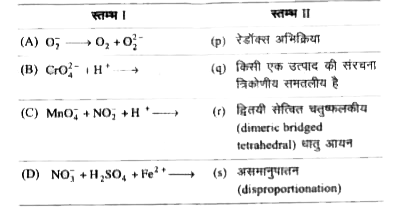निम्न सेल अभिक्रिया पर विचार कीजिए
(2Fe(s)+O2(g)+4H+(aq)→2Fe2+(aq)+2H2O(l), E∘=1.67V),( [Fe2+]=10−3M, p(O2)=0.1)
वायुमण्डल pH = 3, एवं 25∘C पर सेल विभव है
1.47 V
1.77 V
1.87 V
1.57 V
The correct Answer is:D
अर्द्ध-सेल अभिक्रियाएँ निम्न हैं
[Fe→Fe2++2e−]×2 O2+4H++4e−→2H2O¯¯¯¯¯¯¯¯¯¯¯¯¯¯¯¯¯¯¯¯¯¯¯¯¯¯¯¯¯¯¯¯¯¯¯¯¯¯¯¯¯¯¯¯¯¯¯¯¯¯¯¯¯¯¯¯¯¯¯¯¯¯2Fe+O2+4H+→2Fe2++2H2O
अत: अभिक्रिया ने भाग लेने वाले इलेक्ट्रॉनों की संख्या, n = 4
दिया है, [Fe2+]=1×10−3M
P(O2)=0.1 वायुमण्डल
pH = 3,
अत: [H+]=1×10−3
E=E∘−0.0594log[Fe2+]2[H+]4Po2
=1.67−0.0594log(10−3)2(10−3)×0.1
=1.67−0.02952log107
=1.67−0.032×7=1.67−0.105
= 1.565 = 1.57 V
Topper's Solved these Questions
- BOOK - JEE Main & Advanced (Hindi Medium)CHAPTER - रेडॉक्स अभिक्रियाएँ एवं विधुत रसायन EXERCISE - मैट्रिक्स-सुमेल प्रकार3videos
रेडॉक्स अभिक्रियाएँ एवं विधुत रसायन
- BOOK - JEE Main & Advanced (Hindi Medium)CHAPTER - रेडॉक्स अभिक्रियाएँ एवं विधुत रसायन EXERCISE - बहुविकल्पीय प्रश्न II3videos
रेडॉक्स अभिक्रियाएँ एवं विधुत रसायन
- BOOK - JEE Main & Advanced (Hindi Medium)CHAPTER - रासायनिक बलगतिकी EXERCISE - विश्लेषणात्मक प्रश्न18videos
रासायनिक बलगतिकी
- BOOK - JEE Main & Advanced (Hindi Medium)CHAPTER - विलयनEXERCISE - (विश्लेषणात्मक प्रश्न)11videos
विलयन
Similar Questions
स्तम्भ I' में दी गयी अभिक्रियाओं का 'स्तम्भ II' में दी गयी उनकी प्रकृति/उत्पाद के प्रकार से मिलान कीजिए |
 06:40View Solution
06:40View Solutionएक जलीय विलयन में NO−3 आयन के अपचयन के लिए E∘ का मान + 0.96 V है | कुछ धातुओं के आयनों के E∘ नीचे दिए गए हैं
V2+(aq)+2e−→VE∘=−1.19VFe3+(aq)+3e−→FeE∘=−0.04VAu3+(aq)+3e−→AuE∘=+1.40VHg2+(aq)+2e−→HgE∘=+0.86V
जलीय विलयन में NO−3 द्वारा ऑक्सीकृत होने वाला/वाले धातु युग्म है (हैं)View Solutionएक प्रथम कोटि की अभिक्रिया 10 मिनट में 20% पूर्ण होती है। गणना कीजिए
(i) अभिक्रिया का विशिष्ट वेग स्थिरांक
(ii) अभिक्रिया के 75% पूर्ण होने में लगा समय।03:03View Solutionएथेनॉल तथा मेथेनॉल का वाष्प दाब क्रमश: 44.5 तथा 88.7 mm Hg है। समान तापक्रम पर 60 ग्राम एथेनॉल को, 40 ग्राम मेथेनॉल के साथ मिश्रित करके एक आदर्श विलयन बनाया जाता है। विलयन के कुल वाष्प दाब की तथा वाष्प में मेथेनॉल के मोल प्रभाज (mole fraction) की गणना कीजिए।
04:15View SolutionConsider the following cell reation :
2Fe(s)+O2(g)+4H⊕(aq)→2Fe2+(aq)+2H2O(l) Ec−=1.67V
At[Fe2+]=10−3M,p(O2)=0.1atm and pH=3 .
The cell potential at 25∘C is03:03View SolutionConsider the following cell reaction :
2Fes+O2(g)+4H+(aq.)→2Fe2+(aq.)+2H2O(l),E∘=1.67V
At[Fe2+]=10−3M,P(O2)=0.1atm and pH=3, the cell potential at 25∘C is:07:38View SolutionConsider the following cell reaction. 2Fe(s)+O_(2)(g)+4H^(+)(aq)rarr2Fe^(2+)(aq)+2H_(2)O(l), E^(@)=1.67V At [Fe^(2+)]=10^(-3)M,P(O_(2))=0.1 atm and pH=3, the cell potential at 25^(@)C is
View SolutionConsider the following cell reaction
2Fe(s)+O2(g)+4H+(aq)→2Fe2+(aq),2H2O(l),E∘=1.67V
At 25∘C ∣∣Fe2+∣∣=10−3M,p(O2)=0.1 atm, pH =3, the cell potential at 25∘C is04:30View SolutionConsider the following cell reaction.
2Fe(s)+O2(g)+4H+(aq)→2Fe2+(aq)+2H2O(l),
E∘=1.67V
At [Fe2+]=10−3M,P(O2)=0.1 atm and pH=3, the cell potential at 25∘C is02:46View Solutionनिम्न अभिक्रिया में 2Fe(s)+O2(g)+4H+(aq)→2Fe2+(aq)+2H2O(l),E∘=1.67V [Fe2+]=10−3M,P(O2)=0.1 atm तथा pH=3,25∘C पर सेल विभव होगा
05:00View SolutionConsider the following cell reaction:
2Fc(s)+O2(g)+4H+(aq)→2Fe2+(aq)+2H2O(l)E∘=1.67V
At [Fe2+]=10−3M,p(O2)=0.1 atm and pH =3, the cell poteintial at 25∘C is03:51View SolutionConsider the followng cell reaction 2Fe(s)+O_(2)(g)+4H^(+)(aq) rarr 2Fe^(2+)(aq)+2H_(2)O(l) If E_("cell")=E_("cell")^(@) at 25^(@)C and [Fe^(2+)]=10^(-3)M,P_(O_(2))=0.01 atm and pH-x value of x is
03:28View SolutionConsider the following cell reaction: 2Fe(s)+O_(2) (g) + 4H^(+)(aq)to2Fe^(2+)(aq)+2H_(2)O(l) , E^(@) = 1.67V At [Fe^(2+)] = 10^(-3)M,P_(O_2)=0.1 atm and PH=3 . The cell potential at 25^(@) C :
02:34View Solutionनिम्नलिखित सेल अभिक्रिया पर विचार करें:
2Fe(s)+O2(g)+4H+(aq)→2Fe2+(aq)+2H2O(l)
यदि 25∘C पर Eसेल=E∘सेल और [Fe2+]=10−3M,PO2=0.01 atm और pH = x
x का मान है07:20View SolutionConsider the following cell reaction.
2Fe(s)+O2(g)+4H+(aq)→2Fe2+(aq)+2H2O(l),
E∘=1.67V
At [Fe2+]=10−3M,P(O2)=0.1 atm and pH=3, the cell potential at 25∘C isView Solution

